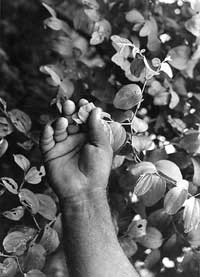Traditional wisdom
 IN SAURASHTRA region of Gujarat, most farmers grow one crop per year. Around Junagadh district in the southern part of the state, peanut and castor are the main cash crops. Peanut gives the best returns, but will only thrive with a heavy monsoon. If the rains are weak, the more drought-tolerant castor is a better hedge. In April and May, the months before the monsoon, farmers must decide what to plant, buy seed, prepare the soil and sow. And wait.
IN SAURASHTRA region of Gujarat, most farmers grow one crop per year. Around Junagadh district in the southern part of the state, peanut and castor are the main cash crops. Peanut gives the best returns, but will only thrive with a heavy monsoon. If the rains are weak, the more drought-tolerant castor is a better hedge. In April and May, the months before the monsoon, farmers must decide what to plant, buy seed, prepare the soil and sow. And wait.
The uncertainty of the coming monsoon - both the date on which it will come, and the amount of rain it will bring - makes summer a season of anxiety for farmers all over India. While the 20th century spread of canals and deepwell irrigation has reduced dependence on the rains somewhat, the monsoon rains remain critical. These farming realities have changed little for centuries. To help reduce the uncertainty of the monsoon, farmers have developed a variety of traditional methods for predicting the nature of the monsoon. "Farmers have to reduce their uncertainty, their risk, using whatever indicators they have available," says Anil Gupta, an expert on indigenous knowledge systems at the Indian Institute of Management (IIM) in Ahmedabad. "Over centuries," Gupta continues, "they've developed ritual belief systems.
Some are not really scientifically based - some are obviously games - non- scientific efforts to reduce psychological uncertainty. But there are others that definitely are based on science, on physical observations - the behavior of birds, the flowering times of trees, wind and cloud patterns, and so on."
Over the past decade, a group of professors at the Gujarat Agricultural University (GUA) in Junagadh has been slowly collecting and systematising local rural weather expertise. In addition to documenting and preserving traditional knowledge, they aim to provide local farmers with a useful monsoon forecast. P R Kanani, an assistant professor with GUA, describes how he happened on this course of research: "In university, I wanted to work on something that would be useful to the local farmers. So I started collecting literature on traditional weather prediction. These were very old texts, very hard to find, some in Gujarati, some in Sanskrit, some only available in religious places
Related Content
- Frontiers 2018/19: emerging issues of environmental concern
- Sustainable forestry for food security and nutrition: a report by the High Level Panel of Experts on Food Security and Nutrition
- Adoption of indigenous paddy cultivation practices by tribal farmers of Tamil Nadu
- Budget 2013-2014: speech of P. Chidambaram, Minister of Finance
- Sustainable farming needed, says M.S. Swaminathan
- Traditional water management systems- An overview of Ahar-pyne system in South Bihar plains of India and need for its revival
